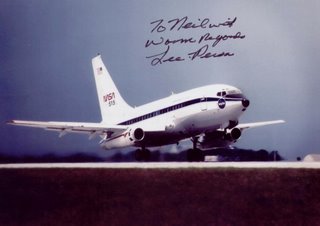Lee H.Person 1932-2012
 Former NASA test pilot Lee Person testing a synthetic vision system at NASA's Langley Research Center in 1989
Former NASA test pilot Lee Person testing a synthetic vision system at NASA's Langley Research Center in 1989
Lee Person was born in Baton Rouge, La., in 1932. He received a commission in the U. S. Marine Corps and served as a fighter pilot and tactics flight instructor until he was released from active duty in 1958. Person earned a Bachelor of Science degree in mechanical engineering from North Carolina State University and joined NASA’s Langley Research Center in 1962, where he was the author and/or co-author of 36 technical publications on results of his research efforts.
Person was also a part of NASA's historic moon landing
research. He tested a number of one-man lunar flying devices and worked on
orbital missions and space station rendezvous simulations. Chief among his
space research tasks was Gemini – Lunar Excursion Module docking simulations,
flying lunar landing simulations and participation in the development of the Rendezvous
and Docking Simulator at Langley.
Person also did pioneering work in the use of in-flight thrust vectoring in close air combat for military fighters and in advancing modern “glass cockpit” design for aircraft. He flew more than 100 different types of aircraft and rotorcraft during more than 10,000 flight hours.
Person was inducted into the Virginia Aviation Hall of Fame
in 2011 for his extensive roles in improving aviation safety and advancing
aeronautics research.In the 1980s and '90s, with Person as chief test
pilot, NASA Langley spent six years developing radar to combat potentially
deadly wind shear. He and fellow pilot Dick Yenni, now retired and living in Williamsburg, flew a
specially equipped jet into hazardous weather to test the technology. Their
work led directly to the hardware and procedures used by today's transport and
general aviation pilots to avoid dangerous and potentially fatal encounters
with wind shear.


<< Home